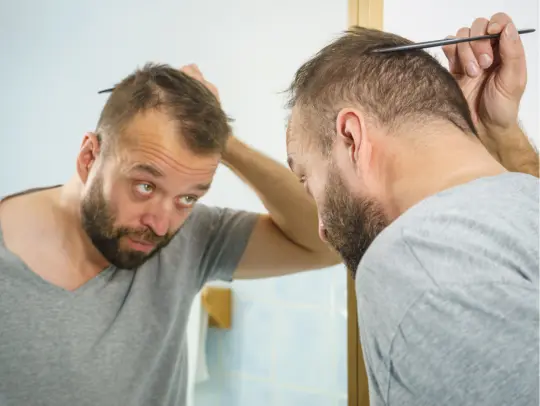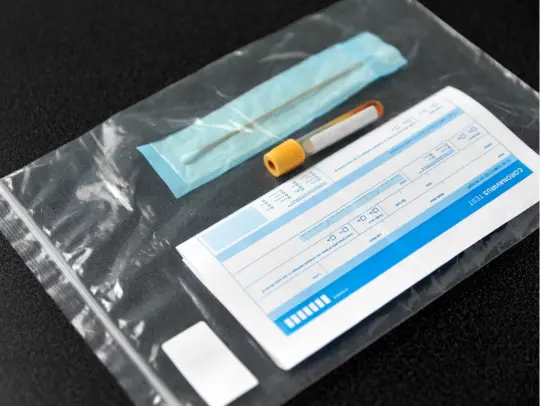
Nurse Practitioner Clarissa - The 4 Stages of Hair Growth Nobody Tells You About
The 4 Stages of Hair Growth Nobody Tells You About
Ever wonder why some of your hair falls out while other strands keep growing? Or why that one haircut took forever to grow out while another seemed to sprout back overnight? The secret lies in understanding the four distinct stages of hair growth that every strand on your head cycles through.
Let's break down these stages and discover how you can use this knowledge to keep your locks looking their best!
Stage 1: Anagen (The Growth Phase)
This is when all the magic happens! During the anagen phase:
- Your hair actively grows about half an inch per month
- This phase lasts between 2-7 years (yep, years!)
- This stage determines your maximum hair length (16-32+ inches depending on your genetics)
- About 90% of the hair on your head is in this phase right now
Think of this as your hair's productive phase – it's putting in the work to get longer, stronger, and thicker. The longer your anagen phase lasts, the longer your hair can potentially grow.
Stage 2: Catagen (The Transition Phase)
Time for a breather! During the catagen phase:
- Your body signals the hair to stop growing
- Hair follicles shrink and detach from the blood supply
- This phase only lasts a few weeks to months
- Only about 1% of your hair is in this phase at any time
Think of this as your hair's cool-down period. It's like your hair is saying, "I've done my growing, time to take a break!" Don't worry about the detachment part – it's completely normal and making way for new growth.
Stage 3: Telogen (The Resting Phase)
Nap time for your hair! During the telogen phase:
- Your hair has completely detached from your scalp's blood supply
- New hair follicles begin forming underneath
- Your shedding rate slows down
- About 10-15% of your hair is in this phase
This resting phase is actually preparing for something exciting – new hair growth! Under the surface, your body is getting ready to start the cycle all over again.
Stage 4: Exogen (The Shedding Phase)
Out with the old, in with the new! During the exogen phase:
- Old hair falls out to make room for new growth
- This phase lasts about 2-7 months
- Losing 50-100 hairs daily is completely normal
- Hair naturally falls out during washing, brushing, or styling
Those hairs you find in your brush or shower drain? They're mostly in the exogen phase. Don't panic when you see them – it's just your body's way of making room for fresh, new strands!
How to Keep Your Hair Healthy Through All Four Stages
Now that you understand your hair's life cycle, let's talk about how to support it through each stage. While you can't control factors like genetics and hormones, there's still plenty you can do to help your hair thrive:
Feed Your Follicles
Your hair needs nutrients to grow strong and healthy. Focus on:
- Protein-rich foods: Fish, lean meats, beans, legumes, and low-fat dairy
- Essential vitamins: Vitamin D, Vitamin C, Vitamin B12, and folic acid
- Key minerals: Iron and zinc
Think of your diet as the foundation for great hair – without the right building blocks, even the best hair care products won't work their magic.
Stress Less for Better Tresses
According to the Mayo Clinic, high stress levels can trigger three different types of hair loss:
- Telogen Effluvium: Pushes too much hair into the resting and shedding phases too quickly (hello, handfuls of hair!)
- Trichotillomania: Creates an irresistible urge to pull hair from your scalp
- Alopecia Areata: Causes your immune system to attack healthy hair follicles
Make time for stress-busting activities like:
- Regular exercise
- Meditation or deep breathing
- Yoga or tai chi
- Getting enough sleep
- Professional counseling if needed
Your hair will thank you for keeping those stress hormones in check!
Pamper Your Hair (But Don't Overdo It)
Gentle hair care goes a long way:
- Choose shampoos and conditioners designed for your specific hair type
- Skip the scalding hot showers – lukewarm water is much kinder to your scalp
- Treat wet hair with extra care – it's more vulnerable to breakage
- Turn down the heat on styling tools when possible
- Give your hair regular breaks from tight styles, chemical treatments, and heat styling
Products That Support Healthy Hair Growth
If you're looking to give your hair a little extra help through its growth cycles, these are worth considering:
FDA-Approved Treatments
- Finasteride (1mg): Prescription medicine that helps block DHT (available through OurDoctor or your physician)
- Minoxidil (2% or 5%): Available over-the-counter as a foam or solution
Supplements for Hair Support
The PeakBody formula for hair growth contains essential nutrients that support all stages of the hair growth cycle. Many users report seeing results in just 3-4 weeks!
- Take two tablets daily with meals
- Contains no fillers
- Non-GMO and GMP certified
- 60 tablets per bottle (one-month supply)
This supplement works by providing the vitamins and minerals your hair needs to thrive during the anagen phase while helping protect against premature shifting to the telogen and exogen phases.
The Science Behind DHT and Hair Growth
Ever wonder why some people lose their hair while others keep a full head into their 90s? DHT (Dihydrotestosterone) often plays a major role:
- DHT is a hormone that helps develop muscle and facial hair
- In people prone to balding, DHT attaches to hair follicles and gradually shrinks them
- Smaller follicles produce thinner, weaker hairs until they stop growing altogether
- Women can benefit from some DHT for hair strength, but too much can cause problems
- An enzyme called 5-alpha reductase is involved in converting testosterone to DHT
This is where treatments like Finasteride come in – they work by blocking the production of DHT to help maintain your follicles in the active growth phase longer.
How Minoxidil Works Differently
While Finasteride tackles DHT, Minoxidil takes another approach:
- Increases the size of hair follicles in the anagen (growth) phase
- Shortens the telogen (resting) phase
- Helps regrow hair and increase its thickness
- Available in PeakBody's 5% solution with their hair growth kits
Don't be alarmed if you notice increased shedding when you first start using Minoxidil – this is actually a good sign! It means your thin, weak hairs are being pushed out to make way for stronger, healthier growth.
Your 4-Step Hair Regrowth Game Plan
Based on patient feedback, here's a comprehensive approach that targets all four hair growth stages:
- Get a prescription for Finasteride (1mg) from OurDoctor or your physician
- Find the right Minoxidil formula (foam or solution) for your needs
- Take a daily hair support supplement like PeakBody's formula
- Use a scalp massage device to stimulate follicles and increase blood flow
Pro tip: Take your Finasteride in the morning and apply Minoxidil at night (or vice versa) to maintain consistent levels throughout the day.
If you're following this regimen consistently for 3-6 months without seeing results, consult your doctor – there might be an underlying condition that needs addressing.

Hair Growth for Women
Womens Hair Growth Treatment
Womens Hair Growth Treatment Natural SupplementsRegular Price $49.00
Your Price Buy Now!
Coupon automatically added to your cart
The Bottom Line on Hair Growth Cycles
Everyone's hair grows and falls out at different rates, but we all go through these same four stages. Understanding this cycle helps you:
- Recognize what's normal shedding versus potential problems
- Choose treatments that target the specific stages where you need help
- Have more realistic expectations about how long improvements will take
- Better evaluate whether hair loss treatments are working
Remember, hair growth is a marathon, not a sprint. Changes to your hair cycle take time to show results – typically at least 3-6 months – so patience is key!
Whether you're looking to maintain your luscious locks or encourage new growth, supporting your hair through each of its four life stages is the secret to healthier, stronger hair for the long run.
























































